A Slice of Sound: Enhancing Domino’s Sonic Branding for Even Greater Impact on Consumers
Alex Greve
October 3, 2023
On an otherwise mundane Sunday during the prolonged stretch of COVID lockdown, my wife and I were preparing quite the extravagant brunch. Just as we were in the thick of our preparations, we unexpectedly bumped into our neighbours right in our block, who, to our surprise, had similar brunch plans of their own. Seizing the opportunity for connection, we decided to pool all our food together, resulting in a lavish spread that was nothing short of spectacular. I remember so vividly how we raised our glasses high, toasting to the very thing that had kept us apart yet brought us together: “Here’s to lockdown!”
Now, I fully realise we were in quite a fortunate situation—not working as first-line healthcare workers and still having a job to begin with! Having said that, I cannot recall any other time in my life of putting so many hours in and juggling so many responsibilities, as I am sure most of us can attest. The restaurant operator I was contracting with was working around the clock to maximise the efficiency of their delivery channels. But about that, I will write another day. What counts is that on that particular Sunday morning, being able to enjoy good food and the company that came with it—brought solace.
Recognising this universal need to reconnect and find comfort in the company of others inspired Domino’s UK & Ireland at the height of lockdown to create a powerful narrative around the theme of reunion through food.
In this blog post, as part of my series of brand reviews, I’ll take a closer look at Domino’s branding and its delivery offerings through different platforms, its strengths and weaknesses, and options for improvement. I will review past and current campaigns and new methods, such as sonic branding. And leave some Easter eggs for how I think their campaigns can be strengthened even further. So let’s dive in!
A Slice of History
Before we delve into the world of Domino’s branding activities, let’s revisit the pizza giant itself. Domino’s Pizza has been serving piping hot pizzas since 1960, when two brothers opened “DomiNick’s” store in Michigan, USA. Those three dots on Domino’s logo stand for the original plan to only open three stores. Low and behold, six decades and almost 19 thousand stores later, Domino’s is the largest pizza company in the world in terms of system sales.
The first Domino’s store in the UK was established in 1985, making it a household name in the UK and Ireland. Now, with 1,200 stores across the two countries and selling 100+ million pizzas a year, their iconic statement of being a tech company first and a food company second has turned out to be quite a successful mantra. One that other companies are keen to copy.
As Domino’s Chief Marketing Officer Sarah Barron puts it herself, Domino’s wants to be the Netflix of pizza. Because in these times, if one does not innovate themselves, somebody else will do it for you. And as a result, you might just become obsolete, like Blockbuster fell prey to the never-ending innovation coming from Netflix and eventually other streaming services.

Revisiting Lockdown and the Yodel Campaign
At the beginning of the Corona lockdown, although Domino’s managed to stay open because they lacked footfall to their stores, they were facing a harsh time as they were losing market share to other platforms such as Deliveroo, which invested a lot of money into advertising right away. They realised that people were desperate to see their friends and family, so Domino’s decided to establish itself as the food of reunion. Their Yodel ad campaign (Do-mi-no-ooh-hoo!) was a direct result of that.
Even though the reviews were mixed—some loved the ad, some loved to hate it—the effectiveness was undisputed, even leading to an IPA Effectiveness Award in 2022.
Ways to improve upon the campaign
Even though the Yodel ad campaign was very effective, I believe that if they had approached it from an omnichannel point of view (and it isn’t too late yet!), the effects of it could have been even stronger. A few ideas on how they could have ‘milked’ the Yodel ad even further, using their distribution channels:
- In-app Yodel recognition: Let the Domino’s app recognise different yodels, as showcased in the ad. As in: ‘Pronounce (yell) it right, and that particular pizza with your desired topping is added to your cart’. And reward consumers by unlocking loyalty points or discounts with certain yodels.
I mean, imagine the scene. You are standing at the train station, seeing people yodelling against their smartphones. Would that make any sense from an UX point of view? As in, is it truly faster to add products to the cart this way versus a few taps or clicks? No. Absolutely not.
Is it gimmicky? Absolutely.
But it is one feature that could result in quite a bit of social media buzz. Especially if you manage to gamify the functionality and reward the user with additional loyalty points when a Yodel-initiated order is completed. And from a tech point of view, it isn’t that hard to do nowadays with the advance of voice-recognition open-source models or end-to-end cloud-native services. - Sonic coupons: Similarly to rewarding yodel-initiated orders with loyalty points, introduce yodels that function as coupons via Domino’s social media outlets. Sonic coupons unlock discounts during checkout. For sure, this would be far more exciting and share-worthy than ‘HALLLOWEEN23’, don’t you think?
There are loads of other options, such as yodel hotspots unlocking offers, or voice-activated billboards, but as a brand, one has to strike a balance between functionalities being fun and running the risk of cringe.
As mentioned, the Yodel ad was rather divisive as it is, with some loyal customers placing complaints. Still, in times of fierce competition, it has helped the brand stand out. There is no bad publicity, as they say!
In 2021, Domino’s launched its first-ever Christmas campaign by introducing its first festive menu combined with the Yodel campaign. It’s the same idea of friendship amongst family and friends, just with a celebratory twist. The ad is set in a town hall with a Christmas choir, where instead of a Christmas carol, you hear “Domin-oh-hoo-hoo”, calling everyone for a slice of pizza after the show. The ad finishes with the yodelling choir and audience all enjoying Domino’s pizza backstage. They used this campaign as part of their sonic branding strategy, which we will talk about in a bit more detail.
So what is this Sonic branding thingy?
More often than not, we associate an image or a logo with a company’s brand. However, what about a sound? Like, what would a wedding ring knocking on wood, a slow-downed anvil sound, muted drum hits, or the sound of a guitar make you think of?
Drawing a blank? So was I. Because individually, all of these sounds can mean nothing or a specific experience to a certain person, but when you put all of them together, you get around-the-world-recognised sounds heard before every movie or episode streamed on Netflix. It’s a sound that stimulates an emotional reaction, a memory, or a desire to go watch some movies, aka, consume the product. When you have to fight for attention on a growing number of media channels, this type of emotional connection with any brand is being heavily recognised, and more and more companies are looking to gain legal protection to secure the sounds associated with their name. Sonic branding is evolving from being a nice touch to an essential brand component. Could Yodel become Domino’s sonic brand?
Making A Single Brand Value Stick
When you think about Domino’s, you instantly see a slice of pizza in your head. Also, people tend to associate fast delivery with fresh and hot pizza. Now, thanks to the campaigns, consumers might remember and recall the yodels as well.
But how does Domino’s go beyond that and create a brand narrative rooted in beliefs and values? How can Domino’s brand connect with a specific emotion?
If being the ‘food of reunion’ is truly what the brand is after, how about they let it govern all of their marketing and branding actions? It’s a simple idea at first, but if done consistently, it works, and there are multiple ways to go about this:
Here are a few ideas on how Domino’s can leverage reunion and friendship in an omnichannel fashion:
- Group gatherings around events: think Premier League, Champions League, EURO 2024, Olympics 2024, etc.
Now the Domino’s app already features group ordering, which is excellent functionality for supporting this. And “Domin-oh-hoo-hoo” has reappeared very recently in a new campaign targeting football fans.
But it could be taken further, such as timely adjustments to the menu, mentioning the event, and making the menu local. How about red and/or blue-inspired pizza during the Liverpool-Everton derby? Same in Manchester.
Track which British athletes perform well in the Olympics and when their medal game is. Harness group ordering in combination with tailored menu offerings and notifications. And have customers jointly enjoy that sports moment in the office or at home, with pizza in hand.

- Support causes that address loneliness and social isolation. I am stating the obvious here when I say that corporate social responsibility is a thing.
But as a brand, you need to make sure that the causes you support are in harmony with your overall mission. If you do, it amplifies your brand message, and the market or society in general will respond favourably to that.
The Last Bite: Conclusion
Domino’s has already established a strong presence on its own delivery platform and JustEat; however, there is so much more space for growth and exploration of new platforms like UberEats, Deliveroo, etc. By addressing weaknesses and capitalising on opportunities, the pizza giant can continue to dominate the delivery market. I believe that offering topical and localised menu options, promoting exclusive deals, and strengthening their brand message are key steps forward.
And guess what? It turns out the Yodel is not just something of the Central Alps. Apparently, it happens around the world. Bulgaria, Romania, China, Australia, and Norway. Even in places like Hawaii (forward to about 1 minute into the video):
So Domino’s, why not introduce pizza variations from those countries to give any country with a Yodel tradition a place on your menu? Oh, and go ahead and rename your Ham & Pineapple pizza into Domino’s Hawaiian. I know, nothing splits the pizza community more than yellow fruit on pizza, but we will forgive you. There is always the odd friend or neighbour who insists on having it, and it does make for good conversation.
Guten Appetit!